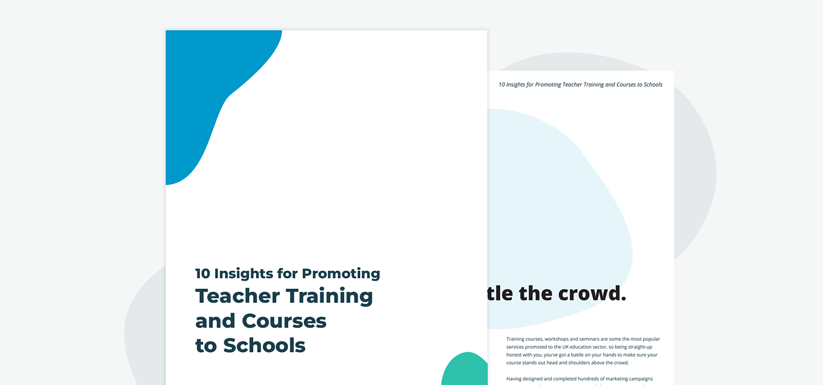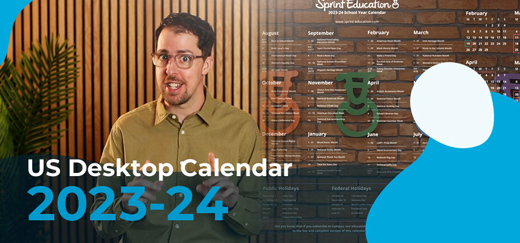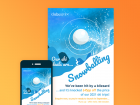11 essential edu-marketing trends for the new decade
11 essential edu-marketing trends for the new decade
Digital marketers estimate consumers now see between four and ten thousand ads per day. These are the trends they are observing to stay ahead of the game in 2020.
Digital marketers estimate consumers now see between four and ten thousand ads per day. These are the trends they are observing to stay ahead of the game in 2020.
The volume of emails sent worldwide is expected to reach 306 billion per day this year, up from 293 billion in 2019 (Statista). In light of this mind-boggling statistic, businesses will have to work harder than ever to cut through and reach the right person, with the right message, at the right time.
Table of contents:
- Segmentation campaigns are an increasingly important tool
- The rising importance of indoctrination campaigns
- The growth of mobile over desktop
- SEO continues to be vitally important and also neglected
- Schools' budgets have altered buying behaviour
- The return of long-format content and copy
- The power of influencer marketing
- Consumers expect a whole new level of transparency
- Chatbots are improving customer experience
- Sales funnels have become a science
- High email deliverability is getting harder and harder

1. Segmentation campaigns are an increasingly important tool
74% of consumers get frustrated when content has nothing to do with their interests (Janrain). To avoid frustrating your audience, it pays to target your communications effectively.
You’re probably already segmenting your data when relevant by location or job title perhaps, but segmentation campaigns will help you identify specific areas of interest amongst these demographics in order to ensure all future marketing they receive is truly relevant. The aim is to use various content, blogs, videos, special offer promotions, and more to see what your audience is engaging with and then continue to give them what they want.
For example, if you offer playground equipment, you could run a segmentation campaign to determine which products are of most interest (swings, climbing frames) and you can also drill down on the factors that are most important to them (price, safety, SEND specific equipment, health and fitness). You can then ensure that the content you send going forward is tailored towards the products they are interested in, and the messaging focuses on the key factors that will influence their decisions.
So, before sending your next campaign, think about the various ways in which you can engage with your audience and tailor your message accordingly, safe in the knowledge that recipients are 75% more likely to click on emails from segmented campaigns than non-segmented campaigns (MailChimp).

2. The rising importance of indoctrination campaigns
That brand-new teacher subscriber who’s just hit your ‘sign me up’ button is currently the most important person on your list and the most receptive. Right now, they’re excited to hear from you, and this is your chance to really wow them. If you put them straight onto your list to receive your next regular update, then you’re not necessarily giving them the welcome they deserve! An indoctrination campaign is the best way to build trust, authority, and, most importantly, a relationship before they receive your regular updates. The best way to do this is to send a short series of beautifully crafted welcome emails.
The first email in your indoctrination campaign should be an engaging, honest, and personal welcome email to briefly introduce yourself, tell your new subscriber what they can expect from your future emails, highlight the benefits of the content they’ll be receiving, and let them know what they need to do next, such as adding your emails to a safe list or perhaps following you on social media. Your follow up emails in this campaign should build the relationship by showing off your best content and emphasising the value of it, and establishing a familiar tone so that you become a regular feature in their inbox, one that they look forward to.
Just remember that this campaign is not about selling. Be clear that they’re receiving these emails as they’ve just signed up, thank them for their interest, and tell them again why they signed up in the first place. At this stage in the relationship, the only thing you should be asking from them is that they ensure that your future emails will arrive safely in their inbox.

3. The growth of mobile over desktop
We discovered last year in our own report that mobile has overtaken desktop as the preferred method of reading emails amongst teachers for the first time, with mobile opens reaching 59% and desktop opens trailing behind on 24.4%. This increase means it’s more important than ever to keep your content easily readable and optimised for mobile. Emails that display incorrectly on mobile may be deleted within three seconds (Campaign Monitor).
Think about writing for an audience reading on their mobile when you create your next email. Don’t assume that writing for an audience on mobile means your emails have to be short though. It can actually be a lot easier scrolling through a long-form piece of copy than clicking on small links on a highly designed email.
This shift in reading emails on the move also plays a part in a trend that has been emerging across every industry over the last few years – the blurring of work and non-work hours. The days of teachers only opening work emails at their desk during the working week is over.
Whilst we certainly don’t want to contribute to the excessive overtime many teachers are finding themselves competing with, it is worth noting that the send times that were traditionally considered ineffective are actually not the no-go they once were and can actually be a good way to avoid the 7am – 10am email ‘rush hour’ when inboxes can become overloaded.

4. SEO continues to be vitally important and also neglected
We understand SEO (search engine optimisation) can seem an often mystifying an intimidating topic, but you must not neglect it.
Organic traffic generated through SEO is more than fives times as effective at generating sales than search ads, and Google is responsible for 94% of total organic traffic.
With that in mind, if you’re marketing to schools, or plan to promote and monetise your content, then you need to get familiar with SEO and Google Search Console – like, yesterday. But don’t panic, with a little time and patience you could be up to speed in as little as a week.
You might have an attractive website, with all the right information, lovely photos, and a perfectly adequate booking system or sales platform but if it’s not visible to teachers, you may well be better off advertising in the local newspaper (if they haven’t gone digital-only as well).
You could compensate for lack of visibility by dumping money into Google AdWords, but wouldn’t it be much better to win a spot on the first page without having to pay for it?
Here’s another reason to learn about SEO.
Optimisation implies you’re improving on something that is already performing. But would you know if your website wasn’t performing? What if, unbeknownst to you, your site has lots of duplicate content, you’ve been stuffing too many keywords into your headers, and the staging site was accidentally indexed?
Not only are you not performing optimally, but you’re not performing at all. Googlebot has crawled your website and discovered these problems, and you’re no longer sat comfortably on page two of the SERPs, but you’re slipping backwards!
We can help.
Dip your toes into search engine optimisation and test the water, then wade into the shallow end with our education-focused guide to SEO.
Don’t head to the Google search bar and jump in at the deep end; you’ll quickly find yourself overwhelmed and exhausted, treading water trying to keep your head above the deluge of blog posts and online courses.
Put on your floaties and ease into our quick guide for learning six simple tactics you can apply right now that will start making an immediate difference to your visibility, no additional software or experience necessary.
SEO is all about saving money and selling more by being visible on the SERPs - get started here.

5. Schools’ budgets have altered buying behaviour
Whatever you’re marketing to schools, be aware of your target audience’s buying power and understand where and when they plan on flexing it.
Austerity looks set to continue as we chart a course for 2020, which means budgets will continue to be tight.
We recently wrote an article on school budgets. In this, we established that almost all school leaders refer to their budgets when making strategic decisions affecting their schools.
School leaders are most likely to make decisions that funnel money toward products and services that are an efficient use of resources while making the greatest impact on their major areas of concern.
So, what are school leaders concerned about?
Improving attainment and results, meeting the curriculum, and keeping their inspection board happy.
Discover where your products and services fit amongst these priorities. That will tell you whom you need to speak to, what objections you might need to overcome, and what competition you might have.
Remember, you’re not just competing against businesses offering solutions similar to your own, but against other branches of the school starved for funding.
Highlight the efficiencies your solutions create over your competitors and provide your audience with the ammunition they need to advocate for your products and services to senior management teams and bursars.
Schools need to know why they should buy your products over 3D printers for the science lab or a new sheltered walkway, and you can make an equally compelling case for both of those things.
When it comes to schools, competition is everywhere.

6. The return of long-format content and copy
If you entered the marketing industry anytime in the last decade, you could be forgiven for thinking long-form copy is a new trend.
The digital age radically changed how we communicate, consume, and share information.
Since the advent of social media and the prevalence of smart devices, many of these new ways of connecting have taken on a short format.
Facebook’s original status update had a 500-character limit, Twitter had a 140 character limit, Instagram was for sharing single photos, and Vine hosted six-second videos.
Once these platforms became mature hosts for advertising, the media naturally took the shape of the medium.
Because of social media’s dominant influence, we assumed that attention spans were shortening and the focus of much marketing became creating short, snackable content.
It is true that you only have a small window to grab readers’ attention, particularly busy individuals like teachers, but there is no evidence to support the hypothesis that human attention spans are shrinking. The notion that there exists a typical length of time that we can focus for is false. The amount of energy and focus we apply in any given scenario is task-dependent and individual.
While short-form content has become popular, social media applications have loosened the constraints on their platforms to accommodate longer forms of content as these boundaries are now seen less as defining features and more as limitations.
Facebook eventually stopped using the term “status update” and now allows for posts of up to 63,206 characters in length, Twitter’s character count doubled from 140 to 280, and Instagram put the kibosh on Vine with Instagram Video allowing users to post video clips more than twice the length.
The origins of long-form as a discipline
Long-format copy may not have been the top trend in marketing for the last 15 years, but it’s not new.
The Robert Collier Letter Book, arguably the best book on writing sales letters, was published in 1931. Robert Collier was writing long-form copy before the BBC began daily radio broadcasts in 1922, back before inboxes replaced mailboxes for direct-response marketing.
There are also examples of long-form content marketing from the late 19th century. In 1895 John Deere began publishing a lifestyle magazine for farmers, at the same time Coca-Cola was publishing full-page ads about its medicinal properties as a “brain tonic”(before 1903 Coca-Cola contained a small amount of cocaine), and shortly after the turn of the century Jell-O, the American equivalent of Hartley’s Jelly, became a household name in the US when they published an entire cookbook of gelatinous delights.
Now, after a brief bout of amnesia brought on by the sudden impact of social media, marketers are rediscovering long-form copy and content and are combining its persuasive power with the precision of email and social platforms to outstanding effect.
Why does long-form copy work?
The same principles that made long-form copy successful in 1895 will make it successful in the education sector for 2020.
Why? Because the human psyche, including that of teachers, hasn’t changed.
We willingly give our attention away for stories, especially stories about us – stories that speak to our desires and instruct us on how to achieve them.
You can’t tell these types of stories in 280 characters or fifteen seconds.
Here are a couple of stats to make you a believer. Short-form advocates, brace yourselves: this is going to come as a shock.
In SEMrush’s 2019 global report on the state of content marketing, they averaged the length of the top 20 traffic-yielding articles in ten industries by word count. The top-performing online education articles averaged 3,674 words in length. For marketing, it was a staggering 5,714 words.
These figures might not accurately represent your industry, but across all ten industries, the lowest average word count for traffic-yielding content was 2,544. There’s a trend here.
Not only does this apply to your articles, blogs, and emails but your advertising on social media too.
AdEspresso ran a test with their Facebook Ads; publishing seven ads that ranged from one sentence to six paragraphs in length. The result?
Not only did the mid to long ads generate the most leads, but they also produced the lowest cost per acquisition.
As for the return of the success of long-form content and copy, it appears it never left.

7. The power of influencer marketing
Influencer marketing is going nowhere in 2020. According to Business Insider, the influencer marketing industry is on track to be worth up to $15 billion by 2022, up from $8 billion in 2019. When we think of influencers, celebrities promoting the latest slimming tea on Instagram are bound to spring to mind, and you might be wondering what on earth this has to do with marketing to schools.
However, an influencer is anyone who is seen as an expert within their niche and therefore, there are influencers within each and every industry. Influencer marketing is really just the millennial version of peer-to-peer, which has been around forever. Recommendations from people and organisations that teachers trust and identify with has always been one of the most powerful marketing tools available.
Ultimately, your audience can be influenced by anyone that can generate trust with their endorsement of a product or service. When emailing schools, there are ways that you can leverage the influence of experts and the teacher equivalent of micro-influencers in the form of testimonials and case studies.
Building close relationships with your teacher clients will put you in a good position to enlist their help in creating authentic content that you can use in your marketing. Perhaps a teacher client has introduced your resource or product at various schools that they’ve worked in. They’re already an influencer for your business, so they might be happy to write a blog post for you and spread the positive message a little further.

8. Consumers expect a whole new level of transparency
Transparency in marketing is essentially being open and honest about your business and letting teachers see the human side behind the glossy marketing façade they’re usually presented with.
In recent years, consumers have become increasingly resistant to anything other than full transparency from businesses they deal with. Facebook has suffered since the Cambridge Analytica scandal, and social media influencers are now legally required to label all paid promotions clearly as adverts. Consumers are armed with so much information and the ability to research businesses in seconds that they’re increasingly savvy and switched on to unfounded marketing claims.
Admitting mistakes, putting your team centre-stage within your marketing and website, giving honest answers to difficult customer questions, and being upfront about pricing all help build trust and an honest relationship with teachers, leading to happy and loyal customers.

9. Chatbots are improving customer experience
Everyone is doing it.
You’ve probably noticed your mobile network provider, travel agent, or favourite online retailers deliver greetings in small windows that pop up when you land on their website. You might also have a long-running conversation with the travel bot Hipmunk in your Messenger app, right next to the one with your Mum.
These are chatbots.
They are not new to technology, some of you might recall chatting with A.L.I.C.E. in the 90s or SmarterChild on AOL or MSN messenger just after Y2K, but they are relatively new to the customer experience.
There are essentially two types: simple and intelligent. Simple bots have scripted answers that are delivered conditionally, and intelligent bots use a degree of AI to deliver user-specific experiences.
A couple of years ago, when chatbots were first introduced into the realm of marketing, they were a trendy marketing topic.
Here was something that could transform the customer experience and had huge implications for businesses looking to save time and money on customer service.
The hype surrounding chatbots fizzled out when designers and developers lost sight of the original goal, improving the consumer experience, and instead began competing to create the cleverest bot with the coolest features.
These bots didn’t add value for the consumer, drained resources, and fell out of favour with marketing teams.
Fast-forward a couple of years, the technology has matured some, and chatbots are back in the spotlight.
Developers have gone back to basics and are now focusing on making bots that offer straightforward services, communicate essential information, and do not overwhelm the user.
The results have been outstanding.
Winnie, a chatbot that helps launch websites, achieved a 72% click-through rate on links to affiliate service providers. When Rewardstream, a company that specialises in referral programs, implemented a chatbot to engage visitors, it accounted for 30% of converted leads in its first 45 days. Kia’s Facebook Messenger chatbot speaks to 115,000 users per week and boasts a 21% conversion rate.
Picture this: your website is a storefront.
It’s fabulously organised, your wares are prominently displayed, and you’re offering mega value. But when a person walks into the shop – it’s empty! Total silence. You’ve got no one to greet visitors, help customers find which of your fantastic products is right for them, or lead them to the checkout.
So what does your prospective customer do? They walk right back out the front door unhelped, totally unimpeded.
You can see how this might be a huge missed opportunity, right?
Many of our education sector clients tell us how teachers often begin conversations via email but then disappear. Why?
Teachers with questions don’t have time to wait for hours or days for a response.
Imagine you’re a teacher working a 60-hour-week managing thirty 11-year-olds equipped with mobile phones and fizzing hormones. You don’t need answers later; you need them now.

10. Sales funnels have become a science
You already have a sales funnel. Every business marketing a product or service online, or offline, has one. What we want to know is: does your funnel successfully filter traffic toward your conversion point or is it leaking?
A good funnel takes consumers through four phases, frequently referred to by marketers with the acronym AIDA (awareness, interest, consideration, and action).
Awareness
The top of the funnel is wide because consumers could potentially discover your business through a variety of mediums. It could be through search, paid advertising, or something different.
Consumers that discover and visit your website become prospects; this is why upping your SEO game and becoming more visible is an important part of setting up a successful sales funnel.
When prospects land on your site, it should be easily navigable, your copy should be tidy, and the content should reflect the visitor’s current level of interest in your product or service. That is - avoid pushing for a sale of your product or service too early, you’ll scare away prospects.
Interest
At this stage, your focus is to turn prospects into leads. The way you go about doing this is by understanding that visitors to your site are doing research and comparison shopping, and trying to qualify you as a viable option. Provide them with informative content that demonstrates your expertise so they can make informed decisions.
While your prospects are browsing your site, reading your blog posts, and viewing your products, offer them the opportunity to join your mailing list. When prospects fill out your data capture form or sign up to your mailing list, they officially become leads.
One of the most effective ways to advance website visitors down your sales funnel to the interest stage is by using a lead magnet. This gated content offers a guide, eBook, video, or another piece of high-value content in exchange for contact info, typically an email address. Whatever form your magnet takes, it should solve a real problem and be of high-value.
If the content fails to live up to its perceived value, prospects will feel deceived and potential leads will walk away.
Decision
Now picture this: a few days, weeks, or maybe even months after the lead signed up to your mailing list in exchange for your gated content, they have decided to make a purchase, and your business has made the shortlist.
How did you get them to make that decision? By nurturing those leads with superb email content that treats them as people instead of commodities. The same way you care for a plant or a child, you have been caring for, developing, and nourishing your leads by feeding them a steady diet of valuable content, useful solutions, and testimonials.
Over time, fostering your leads in this way demonstrates expertise, builds trust, and cements front-of-mind recall, positioning your business as the first and most reliable option when the need for your product arises.
Now all you need to do is live up to expectations. Here’s where you make a superb offer. You’ve accounted for your competitors’ offers, and not only are you going to one-up them with free delivery and installation, but you’re going to include a bonus product to boot.
Action
Just like that, the stranger becomes the prospect, the prospect becomes the lead, and the lead becomes the customer. But the journey doesn’t end at the checkout. Now your focus should shift to post-purchase aftercare, customer retention, and remarketing.
Of all four stages, this one presents you with the greatest opportunity for profit, not because this is where you get paid, but because this is where you earn your customer’s loyalty. It is at least five times more expensive to acquire a new customer than it is to retain a current one. Loyal customers purchase more frequently, spend more than new customers, and small improvements in customer retention result in huge increases in revenue.
Your lead took action, and now it’s your turn to reciprocate. Thanking purchasers for their custom, giving them the opportunity to feedback, and offering support should be standard practice. This touchpoint is the ideal opportunity to initiate the customer into your business ecosystem and begin establishing loyalty.
Soon after, you’ll want to begin remarketing. Avoid scaring away your new customer by carefully considering the frequency and cadence of your communications. Dig into your data to determine when and what to send, making sure that your emails have a purpose.
When current customers receive your marketing after a purchase, it boosts retention by reaffirming that they made a good purchase.
Observe these four stages, and you’ll have a killer sales funnel for 2020.

11. High email deliverability is getting harder and harder
Arguably our most important point for the new year ahead. Email Service Providers (ESPs) like Gmail, Outlook, and Yahoo are tweaking their algorithms all the time to ensure their users get the very best experience and don’t end up with a mountain of spam at the top of their inbox each day. Gmail reported in 2018 that it was protecting Gmail accounts from nearly 10 million spam and malicious emails every minute. It’s important that you make sure your marketing doesn’t get confused for spam.
When subscribers open and engage with your emails, you begin to build a strong sender reputation and gain good deliverability. As long as all your technical sending infrastructure is set up correctly, getting good engagement is the single best thing you can do to boost email deliverability, but how exactly do you do that?
Remain consistent: Huge peaks and troughs in sending rates are likely to raise suspicion as this behaviour is commonly seen from spammers. There’s no hard and fast rule or restriction in terms of how many emails you can or should sent, but consistency is good for your deliverability and it stops teachers from forgetting about you. It’s important you don’t become a constant feature in teachers’ inboxes though – find a good balance.
Provide clarity: It’s good to let teachers know what to expect from your emails, when they can expect them, and what you promise to include. Don’t try to dupe them with unexpected from names or subject lines, and make it easy for them to update their email preferences and unsubscribe if they wish. You want people to unsubscribe rather than mark you as spam as this negatively impacts your deliverability.
Experiement with segmentation: Give your emails the best chance of capturing the interest of your subscribers by personalising your content and then use segmentation campaigns to learn even more about your teacher subscribers’ interests. Analyse engagement to keep your future marketing relevant.
Keep your data clean: Ensure that your list is kept up to date. A small highly engaged list is better than a huge unengaged list. Sending emails to teachers who haven’t engaged in a long time can seriously harm your deliverability, so it’s best to remove any that haven’t engaged. But, before you remove them from your send list completely, try your best to re-engage them. Which leads us neatly on to…
Keep your content fresh: Perhaps teachers aren't engaging because you’ve been sticking to one email approach. It pays to keep your approach relevant and fresh to the ever-changing needs of teachers.
Experiment with your design, the length and structure of your copy, and the assets you include to keep things fresh. If you always send a short impact approach email, maybe dip your toe in the water of long-form copy this year and see what happens! You might just reach some previously disengaged teachers.
Ultimately, if your emails consistently interest your audience, the more engaged they’re going to be. If you can get to know your audience and tailor your message appropriately, you’ll be on your way to good deliverability.
Tags
Marketing
Similar Articles


Marketing Teacher Training and Courses to Schools
Learn 10 game-changing insights especially for teacher training and course providers to enhance your education marketing campaigns when emailing schools.


The Importance of Peer-Generated Content
Learn how to build trust and skyrocket your education marketing with peer-generated content.


Expert marketing to K-12 support and solutions
Expert marketing to K-12 solutions
Email Principals, Teachers, and District Staff Inboxes
Email teachers and staff inboxes
Sell More to US and Global Schools and Districts
Sell more to schools and districts
































